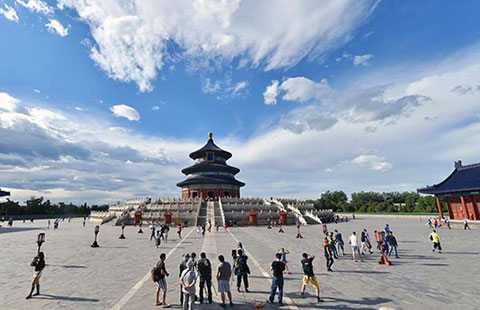Silk Road adventures no longer mean roughing it
By Su Zhou in Yinchuan (China Daily) Updated: 2015-07-03 07:52
|
The Xinjiang International Grand Bazaar is one of the most prominent landmarks in Urumqi and one of the largest bazaars in the world. Zhu Xingxin / China Daily |
Golden opportunities
Industry insiders said the initiative is a new opportunity for China to reintroduce its western regions to tourists and upgrade tourism facilities and services.
Wang Fuzhong, chairman of Ningxia Shapotou Tourism Industry Group, said the tourism industry in western China faces many disadvantages compared with popular destinations in other parts of China.
"Take Ningxia, for example. We don't have much cultural heritage like the Forbidden City or Terracotta Warriors," Wang said. "Besides, restricted by the overall economic situation of the western region, the transportation and tourism industry was not ready for fast development."
Dou Qun, a tourism industry professor at Beijing Union University, said now is a perfect time for China to promote Silk Road tourism products again.
"The Silk Road is one of the early tourism brands that China introduced to the world. It has cultural meanings and a global reputation," Dou said.
And China has developed tourism products along the Silk Road for more than 30 years that all provide a solid foundation for another round of development this year."
Dou suggested that related provinces and regions should focus on cooperation instead of competition.
"Now, many cities all have their own developing plans and want to compete with other cities and provinces in the marketing fight by emphasizing their importance on the Silk Road," Dou said.
Other tourism products
Although the cultural heritage along the Silk Road is a treasure with much potential, northwest China isn't restricting itself to Silk Road tourism products.
Xinjiang has been planning to transform the area into a hub for international medical tourism, seeking to attract patients from Central Asia.
The regional Tourism Bureau and Urumqi Railway Bureau have jointly launched 16 railway tours - including a trip for viewing lavender, a spring outing in the desert and a mulberry picking tour - from March to October. The tours are expected to attract more than 80,000 tourists.
Individual travel by car is also encouraged in the region. Kanas Lake in the far north of the region opened to independent travelers in May.
Ningxia also is exploring creation of a vacation hub for sightseeing and relaxing. The Shapotou Tourism Industry Group invested more than 700 million yuan to build Zhongwei into a "garden in the desert", said Wang Fuzhong, the group's chairman.
Guo Shaoyu in Ningxia, Xue Chaohua in Gansu and Mao Weihua in Xinjiang contributed to this story.
suzhou@chinadaily.com.cn
- Delegation salutes Tibet anniversary
- Officials are told to act as anti-graft watchdogs
- Great Wall safeguarded in united action
- Vice minister pledges more efforts to improve air quality
- Beijing’s efforts to control air pollution start to pay off
- China's military committed to reform
- Netizens rip singer over baby photos
- Central govt's growing support for Tibet
- Monument to be built on Tianjin blast site
- China and Russia seal raft of energy deals








